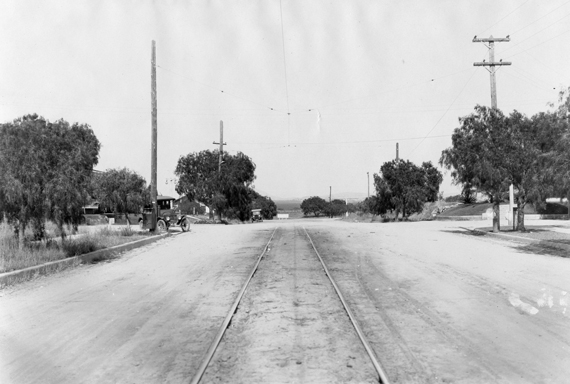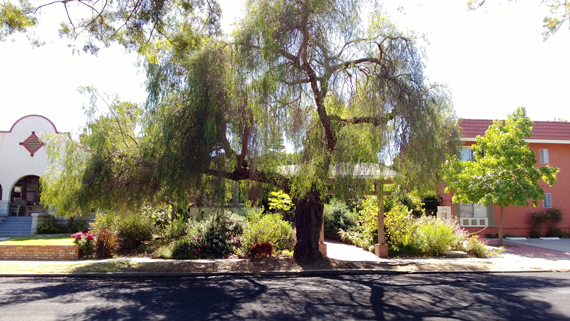|
Historic Trees of Kensington Need Your Voice
By Maggie McCann
September/October 2020
 Young pepper trees line Adams Avenue, looking east from Marlborough Drive, in Kensington, c. 1920. Courtesy Pacific Southwest Rail Museum |
 This tree is over 110 years old and was planted in 1910 when the Kensington Park subdivision was first planned. It is an integral part of the historic fabric of this neighborhood. The Center for Urban Forest Research (CUFR) Tree Carbon Calculator (CTCC) estimates that this tree provides an annual benefit in emission reductions (CO2 equivalents) of 141 lbs. So it's both pretty and it is doing its part to help reduce the carbon in our air. |
"PICTURE TO YOURSELF trees full of fertility lining both sides of all streets and the streets scientifically engineered to form perfect water sheds and surfaced with ten-inch disintegrated granite, with cement aqueducts at all crossings," reads a 1910 newspaper ad for the then-new Kensington Park subdivision. Photos from the day show the young saplings, while later photos from the 1920s, '30s and '40s reveal they had grown to large, arching shade trees.
Over time, many of the original pepper trees disappeared, replaced in large part by queen palms, which became all the rage, or by treeless bricked-in pathways, and the occasional podocarpus or magnolia. Today, 37 of the original California Pepper trees planted in 1910 still remain in the parkways of some original Kensington Park streets: Terrace Drive, Kensington Drive, Marlborough Drive, Edgeware Road, Alder Drive, Madison Avenue, and Monroe Avenue.
California pepper trees, Schinus molle, were originally brought to Spanish California from Peru by the Franciscan friars for their system of missions along the coast of Baja and Alta California. The oldest pepper tree in California, planted in 1830, graces Mission San Luis Rey in Oceanside. All parts of the tree have been used by indigenous peoples and European settlers for flavoring foods, infusing beverages, treating ailments, even tanning leather. The California Department of Forestry counts Schinus mole among the plants that can prevent fire spread when planted strategically.
The City of San Diego created a "Conserve-a-Tree" program under Council Policy 900-19 to encourage residents to nominate trees in the public right-of-way that are significant for age (50 years old or older) and/or for their historic value and significant associations. Kensington's pepper trees meet that criteria, and research is ongoing to determine if the saplings came from Kate Sessions' renowned nursery. The Council policy requires the City to protect and nurture historic community trees to help extend their life.
In August 2018, we submitted a "Conserve-A-Tree" nomination form to the City's Urban Forester for the remaining 37 California pepper trees in Kensington, with the intent of preserving the historic trees and preventing further removals. We included several photos dating from as early as 1913 showing Kensington streets lined with canopies of evergreen pepper trees. The current City Urban Forester refused to process our nomination or to forward it, as required, to the Community Forest Advisory Board for designation action.
Then, Kensington Park residents received a notice that a utilities undergrounding project would begin soon, and an alarm went up with concern for the fate of the trees. A dialogue began between Kensington residents and the office of the City Council president, and assurances were given that none of the historic trees would be cut down without a community meeting. Next, a large white "X" appeared on five of these 110-year-old pepper trees. In January 2020, a historic pepper tree on Edgeware Road was cut down without notice.
Two lawsuits intending to save the trees are awaiting a hearing by the appeals court. But there is nothing stopping Mayor Kevin Faulconer from directing City staff to designate the trees as Heritage Trees under Council Policy 900-19, ensuring that everyone for years to come can enjoy walking Kensington's shady, pepper-tree lined streets.
Please consider sending an email to the mayor's office and ask that he do just that. Here's his contact info:
Office of the Mayor
Kevin L. Faulconer
City Administration Building
202 C Street, 11th Floor, San Diego, CA 92101
(619) 236-6330
kevinfaulconer@sandiego.gov
|
2025
2024
2023
2022
2021
2020
2019
2018
2017
2016
2015
|





